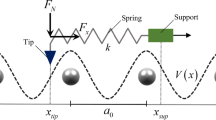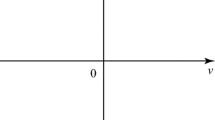Abstract
This work addresses the ‘hard collision’ approach to the solution of planar, simple non-holonomic systems undergoing a one-point collision-with-friction problem, showing that (i) there are no coherent types of collision whereby forward sliding follows sticking, unless the initial relative tangential velocity of the colliding points vanishes; and (ii) the type of collision can be determined directly, given the collision angle of incidence \(\alpha\) and Coulomb’s coefficient of friction \(\mu\) between the colliding points. The classic hitting rod problem is used to illustrate the \(\alpha \)–\(\mu\) collision-type dependence. Finally, the relation between collision with friction and tangential impact problems in multibody systems is briefly discussed.




Similar content being viewed by others
References
Khulief, Y.A.: Modeling of impact in multibody systems: an overview. J. Comput. Nonlinear Dyn. 8(2), 021012 (2014)
Keller, J.B.: Impact with friction. J. Appl. Mech. 53, 1–4 (1986)
Lankarani, H.M.: A Poisson-based formulation for frictional impact analysis of multibody mechanical systems with open or closed kinematical chains. J. Mech. Des. 122, 489–497 (2000)
Yao, W., Chen, B., Liu, C.: Energetic coefficient of restitution for planar impact in multi-rigid-body systems with friction. Int. J. Impact Eng. 31(3), 255–265 (2005)
Djerassi, S.: Stronge’s hypothesis-based solution to the planar collision-with-friction problem. Multibody Syst. Dyn. 24(4), 493–515 (2010)
Stronge, W.: Smooth dynamics of oblique impacts with friction. Int. J. Impact Eng. 51, 36–49 (2013)
Wang, Y., Mason, M.T.: Two-dimensional rigid-body collisions with friction. J. Appl. Mech. 59, 635–642 (1992)
Genot, F., Borgliato, B.: New results on Painleve paradox. Eur. J. Mech. A, Solids 18, 653–677 (1999)
Or, Y., Rimon, E.: Investigation of Painleve paradox and dynamical jamming in mechanics. Nonlinear Dyn. 67, 1647–1668 (2012)
Kane, T.R., Levinson, D.A.: Dynamics: Theory and Applications. McGraw-Hill, New York (1985)
Routh, E.J.: Dynamics of a System of Rigid Bodies, Elementary Part, 7th edn. Dover, New York (1905)
Painleve, P.: Sur les Lois du Frottement de Glissement. C. R. Séances Acad. Sci 121, 112–115 (1895), et 141 401–405, 546–552 (1905)
Leine, R.I., Borgliato, B., Nijmeijer, H.: Periodic motion and bifurcation induced by the Painleve paradox. Eur. J. Mech. A, Solids 21, 869–896 (2002)
Zhao, Z., Liu, C., Ma, W., Chen, B.: Experimental investigation of the Painleve paradox in a robotic system. J. Appl. Mech. 75(2), 041006 (2008)
Poisson, S.D.: Mechanics. Longmans, London (1817)
Author information
Authors and Affiliations
Corresponding author
Appendix
Appendix
An algorithm for collision-type identification based upon Table 1: \(\text{Type}=\text{T}5\) unless
1 | \(ghp > 0 \cup (\alpha /r_{m} < 1 \to T1\ \mbox{or}\ 1 < \alpha /r_{m} < 1 + e{}_{e} \to T2)\) |
2 | \(p < 0 \cup (\alpha /r_{m} < 1 \to T3\ \mbox{or}\ 1 < \alpha /r_{m} < 1 + e{}_{e} \to T4)\) |
3 | h<0→T1 |
An algorithm for collision-type identification based upon Fig. 3: \(\text{Type}=\text{T}5\) unless
1 | \(\mu > |m_{nt}|/m_{tt} \cup (\alpha /r_{m} < 1 \to T1\ \mbox{or}\ 1 < \alpha /r_{m} < 1 + e{}_{e} \to T2)\) |
2 | \(m_{nt} < 0 \cup \mu < |m_{nt}|/m_{tt} \cup (\alpha /r_{m} < 1 \to T3 \ \mbox{or}\ 1 < \alpha /r_{m} < 1 + e{}_{e} \to T4)\) |
Rights and permissions
About this article
Cite this article
Djerassi, S. Planar collision-type dependence on incident angle and on friction coefficient. Multibody Syst Dyn 37, 311–324 (2016). https://doi.org/10.1007/s11044-016-9505-z
Received:
Accepted:
Published:
Issue Date:
DOI: https://doi.org/10.1007/s11044-016-9505-z




